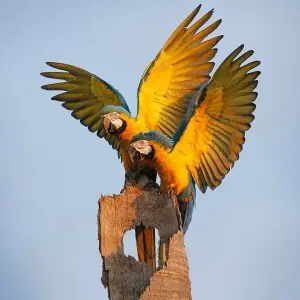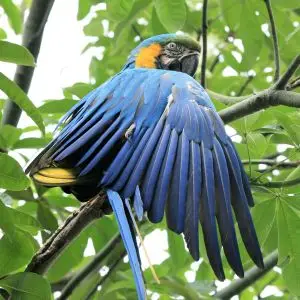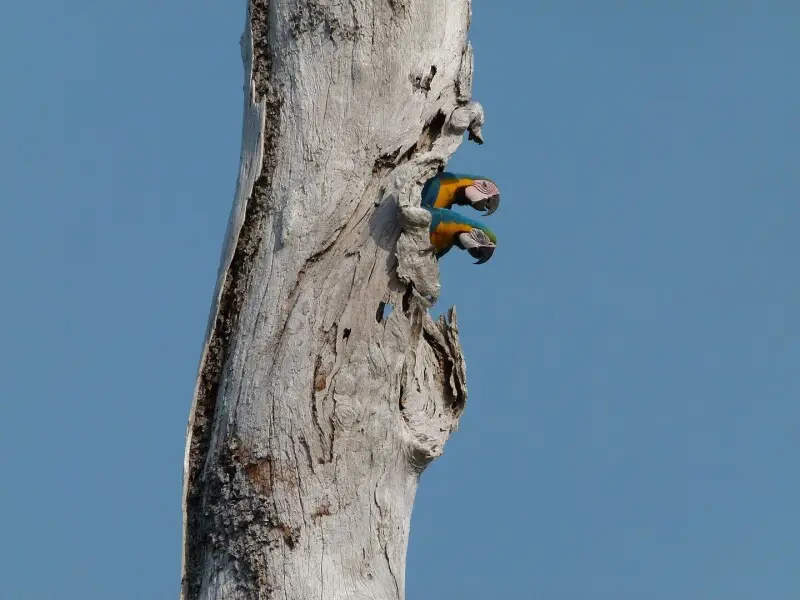Do Males or Female Blue and Gold Macaws Talk Better



Blue-and-Gold Macaw
Blue-and-yellow macaw
The Blue-and-gold macaw is named for its beautiful blue body with a dark lemon-yellow chest. It is also known as the blue-and-yellow macaw. It has a black beak with a strip of green feathers just above it and a feathery black "beard" just below it. Part of its face is without feathers and when it is excited its face will blush pink. Its feet are black or dark gray.
Photos with Blue-and-Gold Macaw





View 25 more photos of Blue-and-Gold Macaw
Distribution
Geography
These macaws are native to Central and South America, and their range includes Venezuela south to Peru, Bolivia, Paraguay, Brazil, and also parts of Panama. They live in tropical forests, woodland, and savannah.

Biome
Climate zones

Habits and Lifestyle
Blue-and-gold macaws form close-knit groups in the wild. They are gregarious and will spend time together with others in their flock, playing, bathing, and hunting for edible fruit in the forest. Macaws tend to enjoy being with their flock mates but during the breeding season, they do partner off to raise their young. These birds communicate with each other by loud screaming and squawking calls. Pairs will fly so close to each other that their wings almost touch. They are active during the day. When looking for food they may form small, noisy flocks in the early morning. By the middle of the day, they begin looking for shade. These macaws are extremely cautious and at the merest sign of danger, they take off into the air, screeching as they go.
Diet and Nutrition
Blue-and-gold macaws eat mainly nuts, seeds, and fruits. Their strong beaks are used to crush seeds and break open nut shells. Sometimes they consume clay from riverbanks to help them digest toxins from unripe seeds they have eaten.
Mating Habits
Blue-and-gold macaws form monogamous pairs and mate for life. The breeding season is from January to July and they breed every year or second year. Nests are made high up in trees, usually in holes made by other animals. 2 to 3 eggs are laid and they are incubated for 24 to 28 days. The young hatch featherless and blind, feathers beginning to develop after 10 days. Fledglings become independent within 3 months. Both males and females look after the young and are very aggressive towards intruders when protecting their families. They gain sexual maturity when they are 3 to 4 years old.

Population
Population threats
The major threat to Blue-and-gold macaws is habitat loss due to Amazonian deforestation. They are suspected to lose a third of suitable habitat within their distribution over three generations (38 years). The other biggest threat is poaching and the illegal pet trade. 55,531 wild-caught individuals have been recorded since 1981 when their trade was restricted by CITES.
Population number
The IUCN Red List and other sources don't provide the number of the Blue-and-gold macaw total population size. Currently, this species is classified as Least Concern (LC) on the IUCN Red List and its numbers today are decreasing.
Ecological niche
Blue-and-gold macaws are important seed eaters in tropical forests. They can have an influence on forest dynamics through eating and spreading seeds.
Fun Facts for Kids
- Macaws crack open buts with their strong beaks. They are also good at chewing up things in your house.
- When a macaw pair can't find their own nest, they take another bird's nest and kill the hatchlings.
- The fruit of the Jabillo tree is a favorite for macaws.
- As with humans, macaws do not talk when they are eating, so it's not easy to see them at that time.
- The macaw likes to remain inside a deep hole in a crumbling tree where he is out of sight.
- Palm trees provide a perfect hiding place to avoid predators like eagles.
- Mating pairs can be easily spotted within a flying flock, as they stay very close to each other.
- Avocados and cherries are toxic for macaws. They can eat apples, oranges, grapes, walnuts, peanuts, and sunflower seeds.
References
More Fascinating Animals to Learn About
Source: https://animalia.bio/blue-and-gold-macaw
0 Response to "Do Males or Female Blue and Gold Macaws Talk Better"
Post a Comment